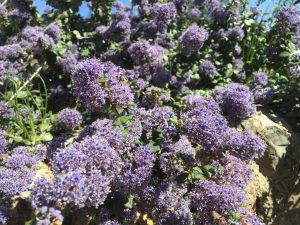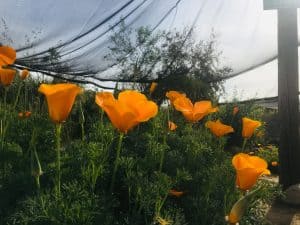 Spring of 2019. Should we call it “The Year of Flowers?” We have several customers and friends who have commented and sent pictures of their natural gardens saying they are “drop dead beautiful.” Not sure where that term comes from, and it doesn’t conjure a good image for gardens so let’s go with “spring to life beautiful.”
Spring of 2019. Should we call it “The Year of Flowers?” We have several customers and friends who have commented and sent pictures of their natural gardens saying they are “drop dead beautiful.” Not sure where that term comes from, and it doesn’t conjure a good image for gardens so let’s go with “spring to life beautiful.”
Last year at this time I wrote, “Not to jump too far ahead but… summer is right around the corner. We have some catching up to do. Check your soil. It might be drier than you think.” That was in 2018. This year (2019), we have no catching up to do, the rains have been copious, the soil is not dry, but this is the perfect time for you to check your soil anyway – to learn what a healthy moist soil looks like. Chances are if you dig down 3-4” in the root zone of your plants, the soil will still be moist to the touch, friable (a little crumbly) and not sopping wet. If this is the case, remember this feeling on your fingers, as this is how you will be checking your soil to determine if you need to water this summer. Whenever your soil is still moist 3-4” deep, and you have been giving the ground the recommended periodic “deep soakings” you will not need to water.
Watering
If by chance your soil is dry right now, best to hold off until the weather forecast reads, “No rain in sight,” which has not happened yet. Anytime in late spring that you are able to postpone a “deep soaking” because more rain is coming, do so, because rain is better than sprinklers. Most established gardens will not need their first deep soaking until around 4-6 weeks after the last good rain of the season. By the way, there is more rain forecast for April, so this season of abundance might not be over just yet. Your first deep soak might be late May. Stay tuned.
Related to Watering
This very simple method of checking soil moisture 3-4” down is done on the assumption that healthy soil stays cool and moist at lower levels, 12-18” deep. This year, with over 22 inches accumulated rainfall falling in perfect amounts at ideal intervals, the soil is for sure moist deep down, where the roots are. Your job this summer will be to maintain that relatively constant moisture level at the root zone depth (approx 14”) by watering thoroughly, only when the soil is dry to the touch 3-4” down. By watering infrequently, your soil will stay moist down deep, and also have a chance to “breathe.” Roots need oxygen as well as water.

Pruning
Very little pruning is needed at this time. Enjoy the new growth and all the flowers. We’ll talk about pruning a little later to get ready for summer. Never prune, or allow anyone to hedge your native shrubs into weird shapes; globes, teardrops, cubes, battleships or even reindeers, unless your garden narrative includes that sort of severe, artificial pruning style. We need to make a stand on this. Ornamental landscape shrubs are being tortured into artificial shapes everywhere we look. But in our natural gardens, let’s do only artful pruning for horticultural reasons, in the proper season and on the right plants for the right reasons. Maybe our style will catch on. The plants and the wildlife will thank you. Plants do not grow in geometric shapes.
Weeding
When you use a hoe or cultivator to eliminate a few small weed seedlings, you get the weed before it sets seed, break the soil surface to allow more water and air to infiltrate, and interact with the garden by being there, plus you avoid spraying toxic chemicals. The skillful use of a hoe in and around garden plants is a beautiful thing. Get good at it and be proud.
Mulching/Top dress
Leave in place any and all small leaves that your plants are dropping onto their own root zones. This is the natural mulch you want. If mulch or top dress has washed away in the rains, you can cover the bare ground with a gritty bark product 1/4 – 1/2” particle size, about 2” deep. Don’t forget that mineral top dressings, i.e.; gravel, dg, pebbles, etc. can be quite effective for a dry, natural look, especially if your garden’s theme is desert or chaparral.
Feeding
No need to apply any fertilizer at this time. If your potted plants are looking tired and yellow, it is because the rains leached the nutrients away. Use an all-purpose, dry plant food or a liquid feed according to label instructions for potted plants.
Troubleshooting – Varmints, Pests, and Diseases
It’s not too early to be on the lookout for Argentine ants. While they do not feed on your plants, they favor the bad guys that do, plus they can undermine the root systems and make water management tricky. What to do. Tough question. Products with growth regulators as active ingredients work more slowly but more effectively that poisons. You might be able to flood a colony out with a garden hose. Call or write if you have questions.
to flood a colony out with a garden hose. Call or write if you have questions.
Annual Wildflowers
Enjoy them in your garden if you sowed seed last fall. If not, find a wildflower hotline or website and enjoy them in the wild. It is too late to sow seed at this time. Plant in October.
Adding New Plants
It is not too late to add new plants, but as the rainy season draws to a close you will need to monitor the moisture levels in both the nursery root ball as well as the soil adjacent to the planting hole. Come see our complete selection of flowering shrubs, subshrubs, forbes, grasses and wildflowers to give your garden a colorful, “rustic” look to finish spring and begin summer.
Engage
Hopefully, this spring is giving you ample time to enjoy your garden… including the plants, flowers, songbirds, hummingbirds, native bees, butterflies (just where were you when the painted ladies came through last month?), pollinators, lizards, frogs, and other critters, and there are plenty out there… and that you can enjoy your place at least as much as they do. They think it’s their place. Good job on that!
From the Garden,
Mike Evans
Questions? Help is just one call or one email away. Call (949) 728-0685 or email (with pictures if you like) our special helpline: gardenhelp@californianativeplants.com